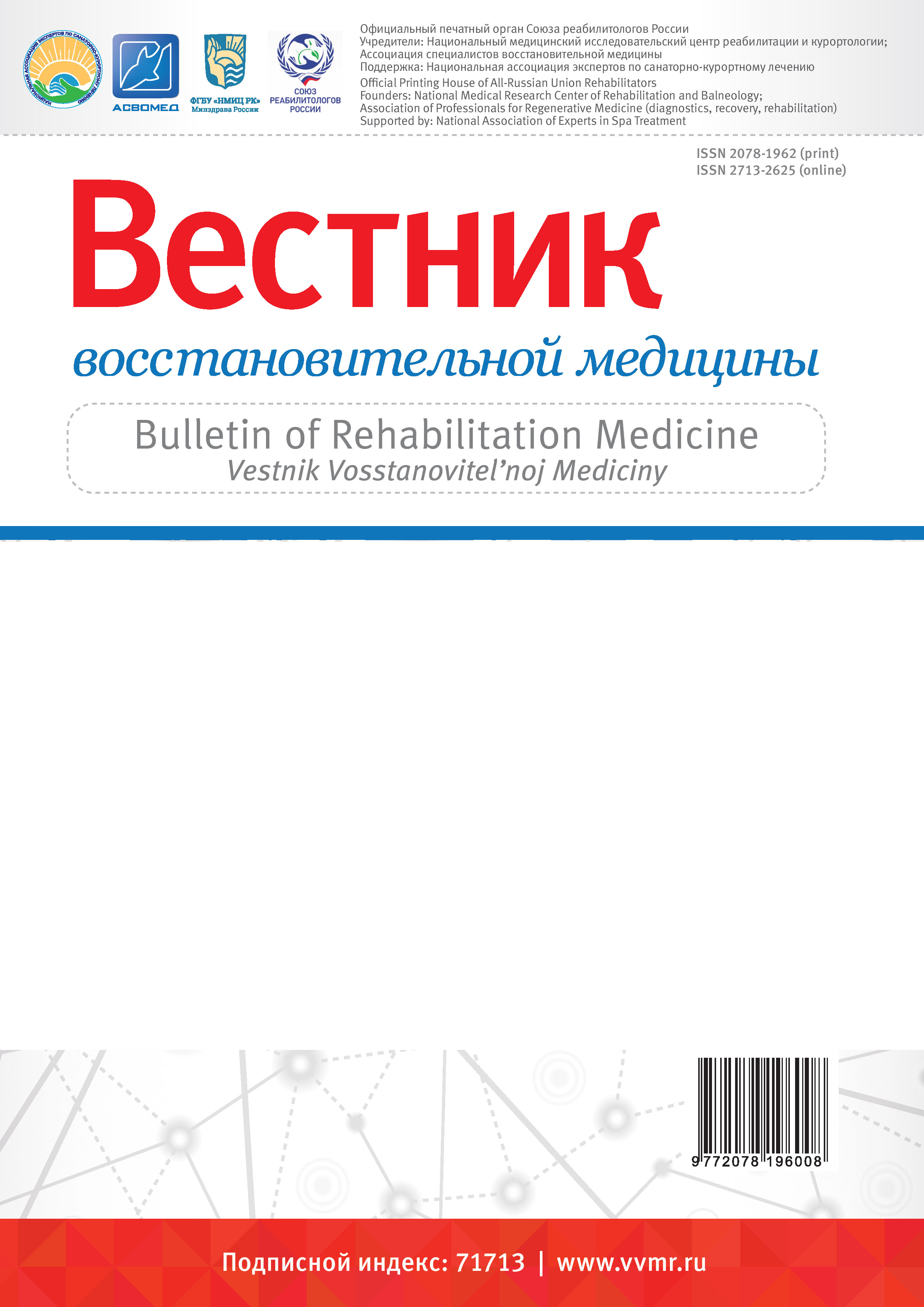Subclinical manifestations of a low-intensity inflammatory process have a significant impact on the development, course and clinical prognosis of the degenerative-dystrophic process. They also lead to structural changes in the vascular network in the focus of chronic inflammation. Subsequent cellular reactions that occur under the action of chemokines and cytokines support developing inflammation, including through structural changes in tissues. The endothelial-mesenchymal transition, which changes the phenotype of the endotheliocyte to myofibroblast, for its part increases the activity of the formation of new structures. As a result of changes in the functional activity of endotheliocytes, pericytes, fibroblasts, macrophages, lymphocytes, epithelial cells, etc. in combination with angiogenesis, increased permeability of vascular walls and edema, lead to the emigration and infiltration of tissues with inflammatory cells, an increase in the number and activity of fibroblasts with the development of fibrosis and a change in the structure of tissue. Thus, the development of a degenerative-dystrophic disease is based on an imbalance of counter-regulatory factors: pro-inflammatory, anti-inflammatory and inflammatory factors, which not only leads to the formation of a chronic systemic inflammatory response and supports it in one area, but also creates conditions for the formation of new foci of chronic inflammation, new sources of phlogogen’s. Given the generalization of the results of the research, the treatment and rehabilitation plan should be based on a combination of the use of etiotropic, pathogenetic and sanogenetic principles. Potentiation of effects when choosing a therapeutic strategy and tactics allows activating the formation of inflammation completion factors, including chemokines, specialized pro-resolving lipid mediators, contributing to the reduction of newly formed vessels and the restoration of normal cellular tissue composition. Subclinical manifestations of a low-intensity inflammatory process have a significant impact on the development, course and clinical prognosis of the degenerative-dystrophic process. They also lead to structural changes in the vascular network in the focus of chronic inflammation. Subsequent cellular reactions that occur under the action of chemokines and cytokines support developing inflammation, including through structural changes in tissues. The endothelial-mesenchymal transition, which changes the phenotype of the endotheliocyte to myofibroblast, for its part increases the activity of the formation of new structures. As a result of changes in the functional activity of endotheliocytes, pericytes, fibroblasts, macrophages, lymphocytes, epithelial cells, etc. in combination with angiogenesis, increased permeability of vascular walls and edema, lead to the emigration of leukocytes and infiltration of tissues with inflammatory cells, an increase in the number and activity of fibroblasts with the development of fibrosis and a change in the structure of tissue. Thus, the development of a degenerative-dystrophic disease is based on an imbalance of counter-regulatory factors: pro-inflammatory, anti-inflammatory and inflammatory factors, which not only leads to the formation of a chronic systemic inflammatory response and supports it in one area, but also creates conditions for the formation of new foci of chronic inflammation, new sources of phlogogen’s. Given the generalization of the results of the research, the treatment and rehabilitation plan should be based on a combination of the use of etiotropic, pathogenetic and sanogenetic principles. Potentiation of effects when choosing a therapeutic strategy and tactics allows activating the formation of inflammation completion factors, including chemokines, specialized pro-resolving lipid mediators, contributing to the reduction of newly formed vessels and the restoration of normal cellular tissue composition.
flatfoot, complex treatment method, rehabilitation, plantagraphic characteristics, orthopedic insoles
1. Ivanova, G.E. Kak organizovat' medicinskuyu reabilitaciyu? / G.E. Ivanova, E.V. Mel'nikova, A.A. Belkin i dr. // Vestnik vosstanovitel'noy mediciny. - 2018. - № 2 (84). - s. 2-12.
2. Ivanova, G.E. Primenenie mezhdunarodnoy klassifikacii funkcionirovaniya v processe medicinskoy reabilitacii / G.E. Ivanova, E.V. Mel'nikova, A.A. Shmonin i dr. // Vestnik vosstanovitel'noy mediciny. - 2018. - № 6. - s. 2-77.
3. Kapustina, N.V. Rezul'taty primeneniya hondroprotektorov v kompleksnom vosstanovitel'nom lechenii sportsmenov s posttravmaticheskoy hondropatiey kolennyh sustavov // Vestnik vosstanovitel'noy mediciny. - 2015. - № 1. - s. 38-42.
4. Mel'nikova, E.V. Ispol'zovanie mezhdunarodnoy klassifikacii funkcionirovaniya (MKF) v ambulatornoy i stacionarnoy medicinskoy reabilitacii: instrukciya dlya specialistov / E.V. Mel'nikova, T.V. Buylova, R.A. Bodrova i dr. // Vestnik vosstanovitel'noy mediciny. - 2017. - № 6. - s. 7-20.
5. Ortopediya: nacional'noe rukovodstvo / Pod redakciey S.P. Mironova, G.P. Kotel'nikova. - M.: GEOTAR-Media, 2008. - 832 s.
6. Rukovodstvo po ambulatornoy hirurgicheskoy pomoschi pod red. P.N. Oleynikova. - 2-e izd., dop. i pererab. M.: GEOTAR-Media, 2018. - 416 s.
7. Travmatologiya i ortopediya: Rukovodstvo dlya vrachey / Pod red. N.V. Kornilova: V 4 tomah. - SPb.: Gippokrat, 2004. - T. 3: Travmy i zabolevaniya nizhney konechnosti / Pod redakciey N.V. Kornilova i E.G. Gryaznuhina. - SPb.: Gippokrat, 2006. - 896 s.
8. Cykunov, M.B. Shkaly ocenki narusheniy pri patologii oporno-dvigatel'noy sistemy s ispol'zovaniem kategoriy mezhdunarodnoy klassifikacii funkcionirovaniya (diskussiya) / M.B. Cykunov // Vestnik vosstanovitel'noy mediciny. - 2019. - № 2. - s. 2-12.
9. Arnardottir, H.H. Resolvin D3 is dysregulated in arthritis and reduces arthritic inflammation / H.H. Arnardottir, J. Dalli, L.V. Norling, R.A. Colas at all. // J Immunol. 2016 Sep 15; 197(6): 2362-2368., doi:https://doi.org/10.4049/jimmunol.1502268.
10. Barden, A.E. Specialised pro-resolving mediators of inflammation in inflammatory arthritis / A.E. Barden, M. Moghaddami, E. Mas, M. Phillips at all. // Prostaglandins Leukot Essent Fatty Acids. 2016 Apr;107:24-9. doi:https://doi.org/10.1016/j.plefa.2016.03.004.
11. Benvenuti, M. Double-Edged Sword: Musculoskeletal Infection Provoked Acute Phase Response in Children / M. Benvenuti, T. An, E. Amaro, S. Lovejoy at all. // Orthop Clin North Am. 2017 Apr;48(2):181-197. doi:https://doi.org/10.1016/j.ocl.2016.12.009.
12. Buckley, C.D. Pro-Resolving lipid mediators and Mechanisms in the resolution of acute inflammation / C.D. Buckley, D.W. Gilroy, C.N. Serhan // Immunity. 2014 Mar 20; 40(3): 315-327. doi:https://doi.org/10.1016/j.immuni.2014.02.009.
13. Chiang, N. Structural Elucidation and Physiologic Functions of Specialized Pro-Resolving Mediators and Their Receptors / N. Chiang, C.N. Serhan // Mol Aspects Med. 2017 Dec; 58: 114-129., doi:https://doi.org/10.1016/j.mam.2017.03.005.
14. Chiang, N. Structural Elucidation and Physiologic Functions of Specialized Pro-Resolving Mediators and Their Receptors / N. Chiang, C.N. Serhan // Mol Aspects Med. 2017 Dec; 58: 114-129., doi:https://doi.org/10.1016/j.mam.2017.03.005.
15. Cho, J.G. Endothelial to Mesenchymal Transition Represents a Key Link in the Interaction between Inflammation and Endothelial Dysfunction / J.G. Cho, A. Lee, W. Chang, M-S Lee et all. // Front Immunol. 2018; 9: 294. doi:https://doi.org/10.3389/fimmu.2018.00294.
16. Colville-Nash, P.R. Angiogenesis and rheumatoid arthritis: pathogenic and therapeutic implications / P.R. Colville-Nash, D.L. Scott // Annals of the Rheumatic Diseases 1992; 51: 919-925.
17. Costa, C. Angiogenesis and chronic inflammation: cause or consequence? / S. Costa, J. Incio, R. Soares // Angiogenesis. 2007; 10(3):149-66. Epub 2007 Apr 25., DOIhttps://doi.org/10.1007/s10456-007-9074-0.
18. Díaz-Flores, L. Morphofunctional basis of the different types of angiogenesis and formation of postnatal angiogenesis-related secondary structures / L. Díaz-Flores, R. Gutiérrez, M.P. García-Suárez, F.J. Sáez at all. // Madrid Histol Histopathol (2017) 32: 1239-1279, DOI:https://doi.org/10.14670/HH-11-923.
19. DiPietro, L.A. Angiogenesis and wound repair: when enough is enough / L.A. DiPietro // Jornal of leukocyte biology, Volume100, Issue5, November 2016, Pages 979-984.
20. Elshabrawy, H.A. The Pathogenic Role of Angiogenesis in Rheumatoid Arthritis / H.A. Elshabrawy, Z. Chen, M.V. Volin, S. Ravella at all. // Angiogenesis. 2015 Oct; 18(4): 433-448. doi:https://doi.org/10.1007/s10456-015-9477-2.
21. Fredman, G. Boosting Inflammation Resolution in Atherosclerosis / G. Fredman, I. Tabas // Am J Pathol. 2017 Jun; 187(6): 1211-1221., doi:https://doi.org/10.1016/j.ajpath.2017.01.018.(16)
22. Majno, G. Chronic Inflammation / G. Majno // Am J Pathol. 1998 Oct; 153(4): 1035-1039., doi:https://doi.org/10.1016/S0002-9440(10)65648-9.
23. Moshage, H. Cytokines and the hepatic acute phase response / H. Moshage // Journal of Pathology, vol. 181: 257-266 (1997).
24. Nathan, C. Ding, Review: Nonresolving Inflammation / C. Nathan, A. Ding // Cell 140, 871-882, March 19, 2010, DOIhttps://doi.org/10.1016/j.cell.2010.02.029.
25. Orlowsky, E.W. The Role of Innate Immunity in Osteoarthritis: When Our First Line of Defense Goes on the Offensive / E.W. Orlowsky and V.B. Kraus // J Rheumatol. 2015 Mar; 42(3): 363-371. doi:https://doi.org/10.3899/jrheum.140382.
26. Ridiandries, A. The Role of Chemokines in Wound Healing / A. Ridiandries, J.T.M. Tan, C.A. Bursill // Int. J. Mol. Sci. 2018, 19(10), 3217.doi.org/10.3390/ijms19103217.
27. Roemer, F.W. Presence of MRI-detected joint effusion and synovitis increases the risk of cartilage loss in knees without osteoarthritis at 30-month follow-up: the MOST study / Roemer F.W. // Ann Rheum Dis. 2011 Oct; 70(10): 1804-1809. doi:https://doi.org/10.1136/ard.2011.150243.
28. Scanzello, C.R. «Innate immune system activation in osteoarthritis: is osteoarthritis a chronic wound?» / C.R. Scanzello, A. Plaas, M.K. Crow // Curr Opin Rheumatol. 2008 Sep;20(5):565-72. doi:https://doi.org/10.1097/BOR.0b013e32830aba34.
29. Scheibner, K.A. Hyaluronan Fragments Act as an Endogenous Danger Signal by Engaging TLR2 / K.A. Scheibner, M.A. Lutz, S. Boodoo, M.J. Fenton at all. Horton // J Immunol July 15, 2006, 177 (2) 1272-1281; DOI: https://doi.org/10.4049/jimmunol.177.2.1272.
30. Senger, D.R. Angiogenesis Cold Spring Harb Perspect / D.R. Senger, G.E. Davis // Biol. 2011 Aug; 3(8): a005090.doi:https://doi.org/10.1101/cshperspect.a005090.
31. Serhan C.N. Novel Pro-Resolving Lipid Mediators in Inflammation Are Leads for Resolution Physiology / C.N. Serha // Nature. 2014 Jun 5; 510(7503): 92-101. doi:https://doi.org/10.1038/nature13479.
32. Serhan, C.N. Anti-Inflammatory and Pro-Resolving Lipid Mediators / C.N. Serhan, S. Yacoubian, R. Yang // Annu Rev Pathol. 2008; 3: 279-312, doi:https://doi.org/10.1146/annurev.pathmechdis.3.121806.151409.
33. Serhan, C.N. The Resolution Code of Acute Inflammation: Novel Pro-Resolving Lipid Mediators in Resolution / C.N. Serhan, N. Chiang, J. Dalli // Semin Immunol. 2015 May; 27(3): 200-215. doi:https://doi.org/10.1016/j.smim.2015.03.004.
34. Serhan, C.N. Treating inflammation and infection in the 21st century: new hints from decoding resolution mediators and mechanisms / C.N. Serhan // FASEB J. 2017 Apr; 31(4): 1273-1288. doi:https://doi.org/10.1096/fj.201601222R.
35. Thurston, G. Angiogenesis in Mice with Chronic Airway Inflammation / G. Thurston, T.J. Murphy, P. Baluk, J.R. Lindsey et all. // Am J Pathol. 1998 Oct; 153(4): 1099-1112., doi:https://doi.org/10.1016/S0002-9440(10)65654-4.
36. Uddin, M. Resolvins: Natural Agonists for Resolution of Pulmonary Inflammation / M. Uddin, B.D. Levy // Prog Lipid Res. 2011 Jan; 50(1): 75-88., doi:https://doi.org/10.1016/j.plipres.2010.09.002.
37. Van Caam, A. Unraveling SSc Pathophysiology; The Myofibroblast / A. van Caam, M. Vonk, F. van den Hoogen, P. van Lent and all, // Frontiers in Immunology, November 2018 | Volume 9 | Article 2452: 1-22, doi:https://doi.org/10.3389/fimmu.2018.02452.





